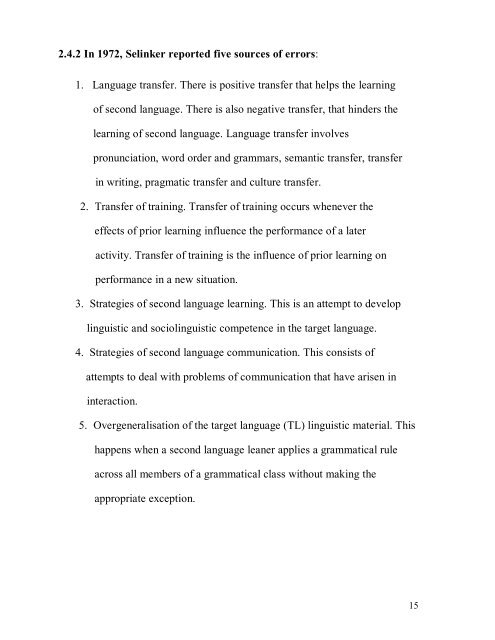error analysis: a study of errors committed by isizulu speaking ...
error analysis: a study of errors committed by isizulu speaking ...
error analysis: a study of errors committed by isizulu speaking ...
You also want an ePaper? Increase the reach of your titles
YUMPU automatically turns print PDFs into web optimized ePapers that Google loves.
2.4.2 In 1972, Selinker reported five sources <strong>of</strong> <strong>error</strong>s:<br />
1. Language transfer. There is positive transfer that helps the learning<br />
<strong>of</strong> second language. There is also negative transfer, that hinders the<br />
learning <strong>of</strong> second language. Language transfer involves<br />
pronunciation, word order and grammars, semantic transfer, transfer<br />
in writing, pragmatic transfer and culture transfer.<br />
2. Transfer <strong>of</strong> training. Transfer <strong>of</strong> training occurs whenever the<br />
effects <strong>of</strong> prior learning influence the performance <strong>of</strong> a later<br />
activity. Transfer <strong>of</strong> training is the influence <strong>of</strong> prior learning on<br />
performance in a new situation.<br />
3. Strategies <strong>of</strong> second language learning. This is an attempt to develop<br />
linguistic and sociolinguistic competence in the target language.<br />
4. Strategies <strong>of</strong> second language communication. This consists <strong>of</strong><br />
attempts to deal with problems <strong>of</strong> communication that have arisen in<br />
interaction.<br />
5. Overgeneralisation <strong>of</strong> the target language (TL) linguistic material. This<br />
happens when a second language leaner applies a grammatical rule<br />
across all members <strong>of</strong> a grammatical class without making the<br />
appropriate exception.<br />
15
















